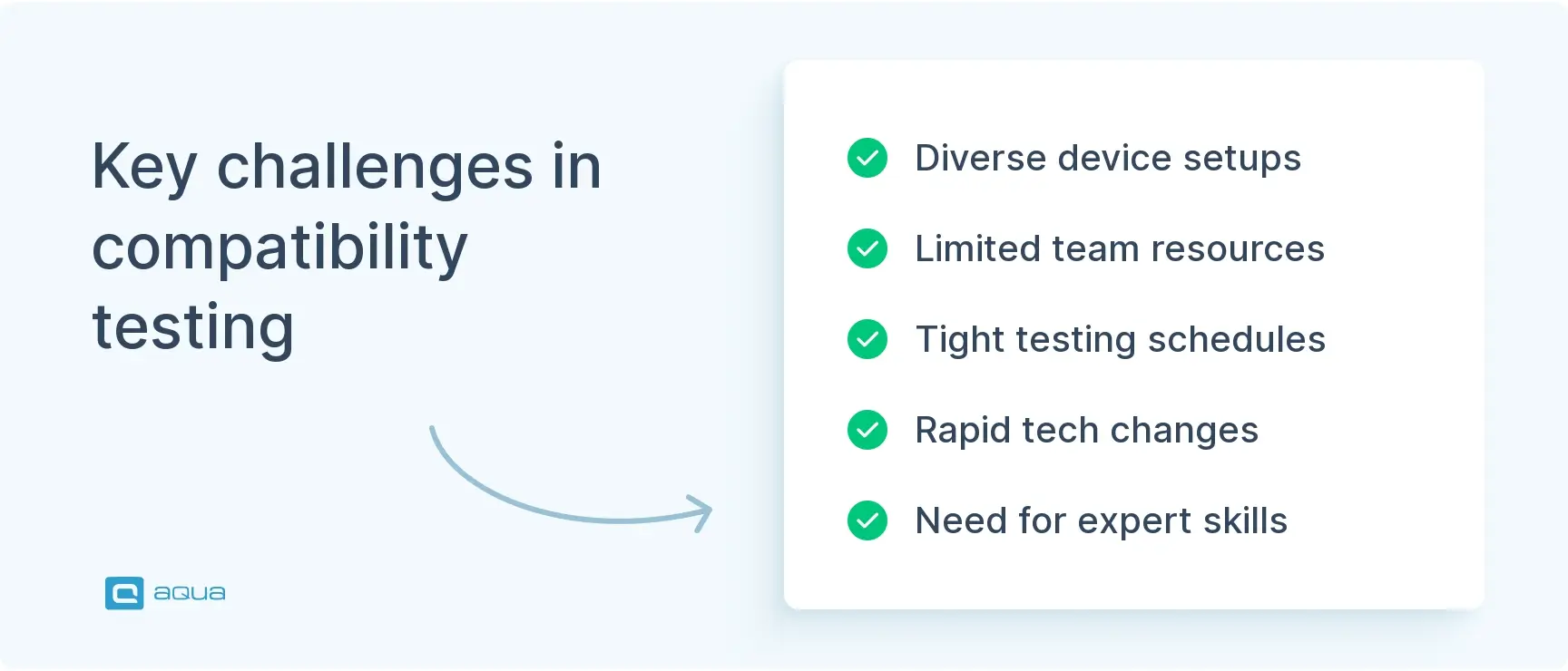In this article, we’ll explore compatibility testing, its importance, and real-world examples of its use in software development. So, whether you’re a developer or a tech-savvy user, embrace yourselves; we will dive deep into the topic.
What is software compatibility testing?
Software compatibility testing ensures software works seamlessly across various devices, operating systems, and platforms, delivering a smooth user experience. It involves testing on different hardware and software configurations, including operating systems, browsers, and mobile devices, to identify issues like bugs or conflicts.
This process is vital for backwards compatibility testing, ensuring the software performs well on older platforms while meeting the needs of a diverse user base. Neglecting compatibility testing can result in poor performance, user dissatisfaction, lost revenue, and reputational damage, making it a crucial step in software development.
You'll want to lean heavily on schemas and design-by-contract upfront to cut compatibility issues by nearly half. For this, you should throw those automated e2e tests into your CI/CD for every critical config, not just the obvious ones.
Testing across multiple environments catches the weird edge cases that only surface when your staging setup differs slightly from production. Start with your most painful integration points first, you'll spot patterns quickly and know exactly where to focus next.
Importance of software compatibility testing
A software compatibility test is crucial for several reasons:
- Ensures smooth user experience: A well-done compatibility testing guarantees smooth functionality across various devices, operating systems, and platforms, leading to users having a hassle-free experience with the software, regardless of the device or system they use.
- Increases customer satisfaction: Delivering compatible software with various devices and systems increases customer satisfaction and loyalty. Users would rather stick with software that works smoothly and consistently across all their devices than switch to a different software due to compatibility issues.
- Saves time and resources: If you conduct compatibility testing early in the development process, you can identify and fix potential issues before release, saving time and resources in the long run.
- Boosts Software Reliability: Extensive compatibility testing guarantees functionality and increases the software’s dependability. Early resolution of compatibility issues helps you produce a more dependable and stable product. Users get confidence from this dependability since they know they can count on the software to function consistently and successfully in various settings.
Types of compatibility testing
Several types of compatibility testing can be performed, including:
- Operating system compatibility testing checks whether the software works correctly on different versions of the operating system, such as Windows, Linux, or macOS.
- Browser compatibility testing ensures the software works correctly on different web browsers, such as Chrome, Safari, Firefox, or Edge.
- Mobile device compatibility testing ensures the software works correctly on mobile devices like smartphones and tablets with various operating systems, screen sizes, and resolutions.
- Hardware compatibility testing checks the software’s performance with different hardware configurations, such as CPU instructions or hard RAM requirements.
- Network compatibility testing ensures that the software works correctly with different network configurations, such as different types of routers, firewalls, and proxies.
- Database compatibility testing checks whether the software works well with databases like MySQL, Oracle, or Microsoft SQL Server.
- Third-party application compatibility testing ensures the software works correctly with different third-party applications like antivirus software or other security tools.
Apart from these, there are 2 types of compatibility testing in QA: forward compatibility testing checks whether the software is compatible with future versions, while backward compatibility testing checks whether it is compatible with older versions of hardware, software, or network configurations.
Here’s your reality check on compatibility testing – you don’t need to test everything under the sun. Smart testers build a config matrix first, mapping out which OS-browser-device combos actually matter for their users.
Grab your analytics data and spot the patterns. Maybe 80% of your traffic runs Chrome on Windows 10, while that edge case Safari-Linux combo barely registers. That’s your testing priority right there.
Start simple: pick your top 5 configurations and test those religiously before expanding. You’ll actually catch more real-world issues by focusing deeply rather than spreading thin across dozens of scenarios.
What you also need to achieve these is a robust, modern Test Management System that can streamline as much as it can. With this type of solution, you can focus your efforts on what matters most and needs human insights.
Building and Using a Compatibility Configuration Matrix
Think of a compatibility configuration matrix as your testing GPS; it keeps you from wandering into every possible rabbit hole. Here’s how to build one that actually works: grab a spreadsheet and list out all the OS/browser/device combos your users actually care about. Pull your analytics data and see where people are coming from; you’ll be surprised how much testing effort gets wasted on setups that barely register 1% usage.
Now here’s the smart part: create three tiers. Tier 1 gets the full treatment (your bread-and-butter configurations), Tier 2 gets solid but streamlined testing, and Tier 3? Just run a quick smoke test to make sure nothing’s completely broken. Start by identifying your top 5 user environments; these become your Tier 1 foundation. Your win comes from updating your matrix every quarter based on fresh user data, so you’re not still testing Internet Explorer while your users moved on years ago.
This is where aqua cloud excels. With over 20 years of experience, aqua cloud is designed to support comprehensive compatibility testing across all platforms. It offers 100% visibility and traceability into your testing processes, allowing you to efficiently manage compatibility tests for various operating systems, browsers, mobile devices, and hardware configurations. Thanks to aqua’s AI-driven features, you can create and manage test cases in seconds. With aqua’s automation integrations, you can also execute compatibility tests seamlessly across multiple environments, ensuring that your software is not only compatible but also optimised for performance.
Achieve 100% flawless compatibility across all platforms with aqua cloud
When to perform compatibility testing?
Performing compatibility testing during the software development lifecycle, particularly during the testing phase, is crucial for identifying and resolving compatibility issues before the software release. This way, you can initiate compatibility testing as early as possible in the development process to proactively address any potential problems with different hardware, software, and network configurations. By conducting compatibility testing early, you can minimise the risk of last-minute surprises and ensure a smoother and more successful software launch. You should also perform compatibility testing whenever you release a new software version or change the system environment.
"Only conducting performance testing at the conclusion of system or functional testing is like conducting a diagnostic blood test on a patient who is already dead."
The process of software compatibility testing
When performing compatibility testing, make sure you go through the following stages:
- Identify the target environment for the software application by analysing the various hardware, software, and network configurations on which the software will be used.
- Create a test plan that outlines the scope and objectives of the compatibility testing, identifying the specific tests like functional testing, performance testing, and user acceptance testing.
- Implement automation by selecting appropriate tools and frameworks to automate the execution of compatibility tests. This effort includes automated configuration setup, test script creation, and result analysis.
- Execute the tests by installing and configuring the software application in the target environment and running compatibility tests to identify any issues or conflicts.
- Troubleshoot and resolve issues by making changes to the software application or the target environment to ensure the software is fully compatible.
- Document and report the results to the relevant stakeholders by creating a detailed report of the testing process that includes issues or conflicts and the steps taken to resolve them.
I believe you can use Cypress for compatibility testing, it works with electron, chrome and firefox. They don't have support for safari though, but you can create a pipeline where you test your site's features in multiple browsers and versions
Challenges in compatibility testing
There are several challenges that software development teams may encounter during the process of compatibility testing:
- Diverse configurations: Testing across the vast array of hardware and software combinations is difficult.
- Limited resources: Compatibility testing demands significant hardware, software, and expertise, which some teams may lack.
- Time constraints: Testing large, complex applications can be time-intensive and hard to fit into tight schedules.
- Dynamic environments: Frequent updates and changes make maintaining compatibility a constant challenge, requiring automation tools for environment management.
- Technical expertise: Specialised knowledge in hardware, software, and networking is essential but not always available.

Edge Cases and Advanced Compatibility Challenges
Compatibility testing has gotten way more complex than just checking if your app works on Chrome versus Safari. You’re dealing with a whole maze of edge conditions that can break your product in unexpected ways.
Think low-resource environments where RAM is tight, accessibility tools running in the background, or that finicky third-party plugin your users love. Hardware drivers can throw curveballs, too, especially with older graphics cards or obscure peripherals. Then there’s the network side: hybrid setups mixing cloud and on-premises systems create connection scenarios you’d never think to test.
Don’t forget about time zones and localisation. Your app might work perfectly in English, but completely fall apart with Arabic text flowing right-to-left. Multi-monitor setups? Those can expose UI bugs that only show up when windows get dragged between screens.
Start with one simple test: intentionally throttle your system resources to about 25% capacity and see what breaks. Studies show teams that proactively test these scenarios catch nearly twice as many critical bugs before release.
Tips for successful compatibility test
Here are some tips for conducting successful software compatibility testing:
- Develop a comprehensive compatibility testing plan that covers all possible hardware and software configurations to ensure accurate results.
- Use automation-minded bug-tracking tools that can help you save time and resources, reduce errors, and increase test coverage.
- Test on real-world configurations that users may encounter to ensure the software application performs as expected.
- Prioritise critical configurations that users will most likely use to ensure the software application is fully compatible with the most important configurations.
- Test early and often to identify compatibility issues early on, reducing the risk of expensive and time-consuming fixes later.
- Involve a diverse testing team with varying levels of technical expertise to identify compatibility issues from different perspectives and increase the chances of finding critical issues.
- Keep up with software updates and changes to ensure the software application remains compatible with the latest technologies.

Compatibility testing example
Suppose you have developed a software application for a client that wants to run on their organization’s network. You need to perform compatibility testing to ensure that the software works correctly and without any issues across different configurations. Here is a use case you may follow:
Use Case: Mobile Compatibility Testing
In this mobile compatibility testing example, let’s look at this scenario: a mobile app development company has created a new social networking application for both Android and iOS platforms. The app aims to provide a seamless user experience across various devices, screen sizes, and OS versions.
To ensure compatibility, the testing team sets up a comprehensive test lab with various devices representing different manufacturers, models, screen sizes, and operating system versions. This includes popular devices like iPhones, Samsung Galaxy phones, Google Pixel phones, and more.
The mobile compatibility testing process involves installing the mobile app on each device in the test lab and executing a series of tests. The tests cover different aspects, such as UI rendering, functionality, device-specific features, performance, and interoperability with other apps or system components.
Throughout this mobile compatibility testing process, the team identifies compatibility issues, such as layout inconsistencies, crashes on specific devices, performance degradation on lower-end devices, or conflicts with other installed apps. Ultimately, they document these issues and collaborate with the development team to address and resolve them.
Example: Figma
Figma is a cloud-based design tool to create, collaborate, and share design projects. The tool needs to ensure compatibility across various operating systems (such as Windows, macOS, and Linux) and web browsers (such as Google Chrome, Mozilla Firefox, and Safari) to ensure a consistent user experience for its users.
During compatibility testing, the Figma testing team should set up different environments with various OS and browsers. They must verify that design projects render correctly, tools and features function as intended, and collaboration features work seamlessly across different platforms.
Compatibility testing will help identify issues specific to certain configurations and ensure that Figma provides a consistent design experience regardless of the platform the user chooses.
Best compatibility testing tools
Here are the top tools for mobile compatibility testing and web apps:
- BrowserStack: A cloud-based platform for testing across multiple browsers, devices, and OS versions, offering real device testing and tool integrations.
- Sauce Labs: Provides scalable, cloud-based automated testing for web and mobile apps, supporting parallel testing on various platforms.
- LambdaTest: A cross-browser testing tool offering responsive, screenshot, and automated testing for web apps.
- Applitools: Focuses on AI-powered visual testing to ensure visual consistency across browsers and devices.
- Browserling: Simplifies live and legacy browser testing with a user-friendly interface and screenshot API.
These tools are excellent for mobile compatibility testing, but a robust TMS can take your testing further.
Let’s introduce aqua cloud. Being the first solution to bring AI to QA, aqua aims at just one goal: taking away the pain of testing. How? Here is what aqua brings to your table:
- A centralised repository for chaotic testing efforts, combining both manual and automated tasks
- Intelligent AI-Copilot that will guide you through 100% of your struggles
- A super-fast AI assistant that will save 98% of your time by creating requirements, test cases and data for you in seconds
- Native Capture integration for visually stunning bug reports
- 100% traceability and control for all your efforts
- 10+ robust automation and project management integrations that include Jira, Ranorex, Azure DevOps, UnixShell, Powershell, Jenkins
What else do you expect from a modern TMS? Just click below and start your transformation right away.
Go beyond software compatibility: achieve software perfection
Conclusion
Software compatibility testing is critical for ensuring your software works seamlessly and without issues in various environments. By identifying compatibility issues early on, you can save time and resources by fixing them before they get costly. By following the tips and best practices outlined in this article, you can perform a full compatibility test and deliver a better user experience to your customers.
If you’re a QA professional looking for a powerful and intelligent tool for your compatibility testing efforts, aqua cloud has everything you need. With its advanced automation and machine learning capabilities powered by GPT, aqua’s AI Copilot can help you create similar tests for different browsers and spot and remove duplicate tests with ease. It also enables you to identify and prioritise the most essential tests to maximise your testing efficiency. Whether you create tests manually or need assistance, aqua’s AI is the solution you’ve been looking for.
Reduce manual efforts and get the most out of your compatibility testing


















